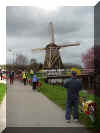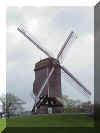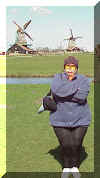Friday - Cold and the Tourist Trap
At our Thursday evening briefing, Armand tells us that our final full day will take us back to our starting point in Amsterdam, with a mid-point stop at a "tourist trap" where we can buy many souvenirs of our visit to Holland.
Friday is cold and windy, but luckily, we travel through a forested area that
helps to break a bit of the wind. It's a nice change of pace from the
farmland and canals. 
 .
The forest also helps shield us a bit from the intermittent snow we will
experience today - it's definitely cold.
.
The forest also helps shield us a bit from the intermittent snow we will
experience today - it's definitely cold.
The tourist trap is a recreation of a typical Dutch village, with working windmills, a wooden shoe shop, and a cheese shop, plus a warm restaurant and the obligatory gift shop and pay toilet (only a guilder - it's clean, but, what a racket!). We have a pannekuken (pancake) at the restaurant and warm up a bit, then stroll through the shops (all nicely heated).
I took a side trip to see one of the working windmills.  This one was used to make peanut oil. After grinding the peanuts with
massive stone rollers
This one was used to make peanut oil. After grinding the peanuts with
massive stone rollers  ,
the meal is heated
,
the meal is heated  ,
then put into a press where the expressed oil is collected
,
then put into a press where the expressed oil is collected  .
.
Windmills
Nothing symbolizes Holland better than the windmill. For hundreds of years the Dutch have used wind power to pump water, grind grain, saw wood, weave cloth, and basically power their country. Though wind power has been largely supplanted by electricity, there are still working mills in operation, though mainly they are used as hooks to bring in the tourists.
There are two basic
styles of windmill. Older mills were built with a small upper house
structure that rotated with the sail assembly  .
Later mills featured a rotating cap that held the sails and initial gears
.
Later mills featured a rotating cap that held the sails and initial gears  ,
with the lower portion of the structure used as housing for the mill
operator. You see some mills that have had the sails removed and the lower
structure converted into housing. Many of the mills are fully
thatched. For a stylistic comparison, here's a photo of a windmill from
Belgium:
,
with the lower portion of the structure used as housing for the mill
operator. You see some mills that have had the sails removed and the lower
structure converted into housing. Many of the mills are fully
thatched. For a stylistic comparison, here's a photo of a windmill from
Belgium:  note that it has a rotating house similar to the early Dutch mills, but the
house is much larger.
note that it has a rotating house similar to the early Dutch mills, but the
house is much larger.
Though the wind is great for windmills, on a cold day, it can be
brutal. 
 We try to find a spot out of the wind.
We try to find a spot out of the wind.
We arrive back at the boat and the rental bikes are taken off for tune up
(every trip gets freshly maintained bikes). One of the Cycletours
mechanics, Pieter, looks me up to show off his recumbent bike.  It's
a really cool speedster made by the Dutch company M5. Pieter is kind
enough to let me take it for a couple of laps around the dockside.
It's
a really cool speedster made by the Dutch company M5. Pieter is kind
enough to let me take it for a couple of laps around the dockside.  Too much fun! Dinner tonight is a nice
buffet. Armand gives out gifts to some of us - Jayne and I get a gift for
riding the strangest bikes.
Too much fun! Dinner tonight is a nice
buffet. Armand gives out gifts to some of us - Jayne and I get a gift for
riding the strangest bikes.
After dinner, the group ![]() walks into Amsterdam and take a canal boat tour of the city. On the
return, Armand gives the group two route choices - one direct to the boat, the
other through the Red Light district. Though the teenagers are
particularly keen on seeing the district, they end up taking the calm route
back, though Tommy, the youngest of the group stays with us for the red light
tour (he looked kind of funny as his mom kept the hood of his jacket firmly over
his face when we passed some of the more explicit clubs).
walks into Amsterdam and take a canal boat tour of the city. On the
return, Armand gives the group two route choices - one direct to the boat, the
other through the Red Light district. Though the teenagers are
particularly keen on seeing the district, they end up taking the calm route
back, though Tommy, the youngest of the group stays with us for the red light
tour (he looked kind of funny as his mom kept the hood of his jacket firmly over
his face when we passed some of the more explicit clubs).